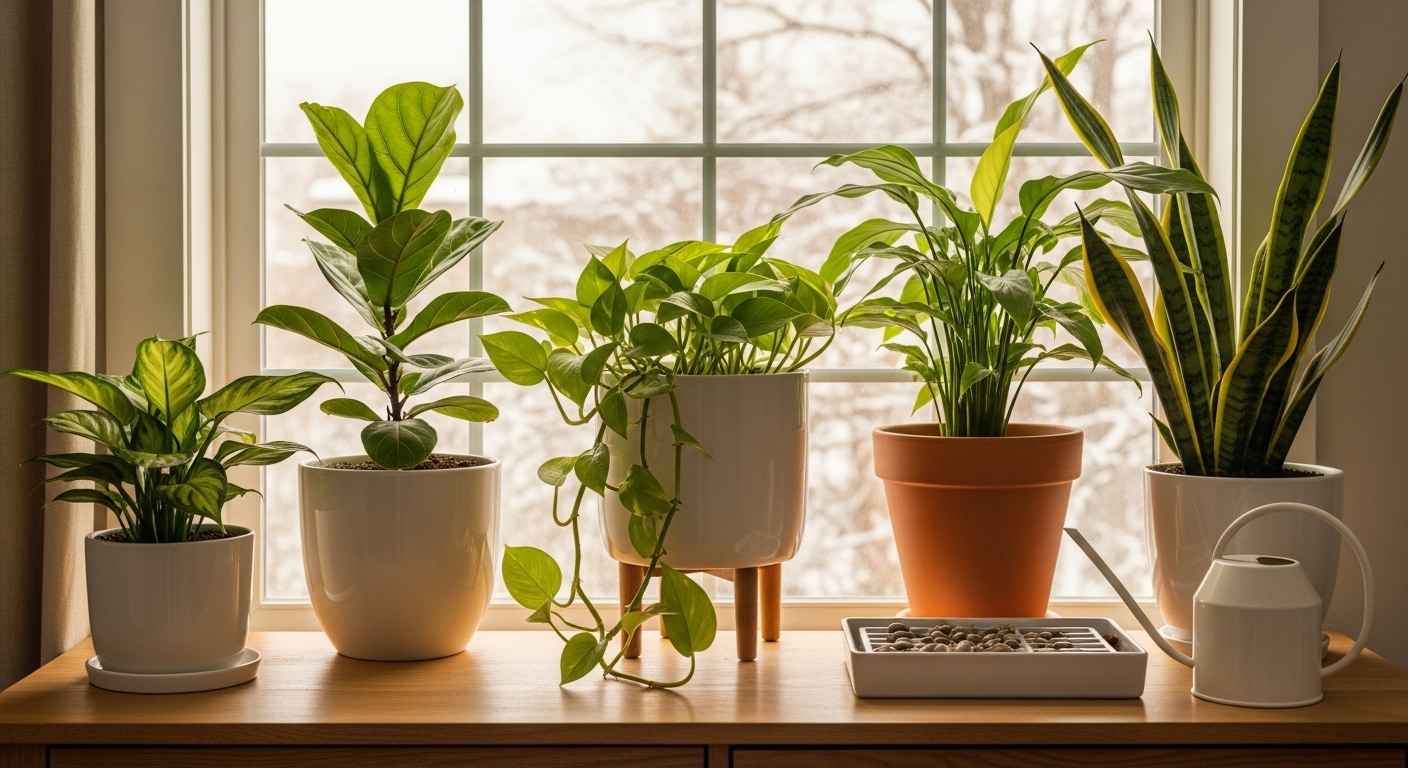Winter can be tough on houseplants. The combination of dry air, shorter days, and temperature changes creates challenges that many plant parents struggle with. Your green friends need different care during these colder months to stay healthy and happy.
Most houseplants slow down their growth during winter. They enter a dormant phase where they need less water, fertilizer, and care. Understanding this natural cycle is the first step to successful winter plant care.
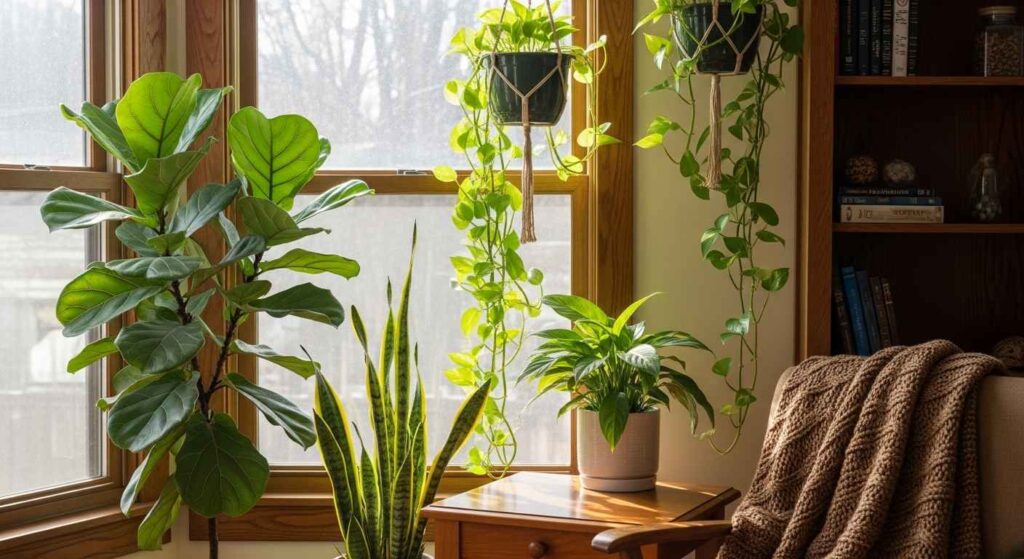
Why Winter Plant Care Differs From Summer Care
Plants are sleeping now, which means they’re conserving as much energy as possible. During winter months, several factors affect your plants:
- Reduced daylight hours: Plants receive 6-8 hours less sunlight daily
- Lower humidity levels: Indoor heating systems dry out the air
- Temperature fluctuations: Hot radiators and cold windows create stress
- Slower growth rates: Plants naturally slow their metabolism
These changes mean your summer watering and feeding schedule won’t work in winter. Plants that thrived with weekly watering might now need water every two weeks or longer.
Essential Winter Watering Guidelines
More houseplants die from overwatering than from any other cause. Winter watering requires a completely different approach:
Check Soil Before Watering
Stick your finger 1-2 inches into the soil. If it feels damp, wait a few more days. Most plants prefer to dry out slightly between waterings during winter.
Reduce Watering Frequency
Cut your watering schedule by 30-50%. A plant that needed water twice a week in summer might only need it once a week in winter.
Water at Room Temperature
Cold water can shock plant roots. Use lukewarm water that’s been sitting at room temperature for 24 hours.
Morning Watering Works Best
Water in the morning so plants can absorb moisture during daylight hours. Evening watering can lead to fungal problems.
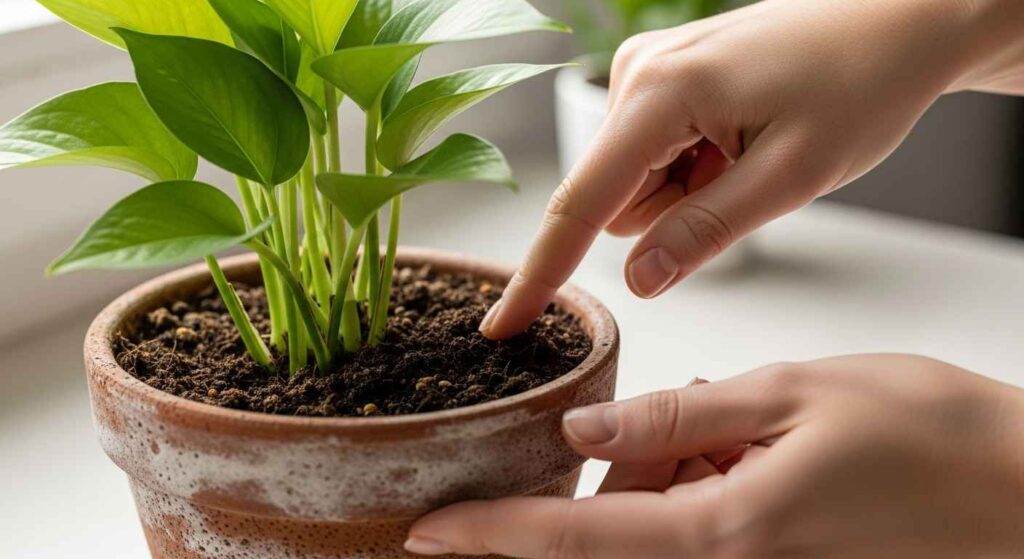
Temperature Control for Winter Plants
Keep your plants away from open windows and front doors, as well as heating units and radiators. During winter, houseplants are more vulnerable to temperature extremes.
Ideal Temperature Range
Most houseplants prefer temperatures between 65-75°F (18-24°C). Avoid these temperature hazards:
- Cold drafts: Windows, doors, and air conditioning vents
- Hot spots: Radiators, heating vents, and fireplaces
- Temperature swings: Areas with big day-night temperature changes
Creating Stable Conditions
Move plants away from windows at night if temperatures drop significantly. Use curtains or blinds to create a buffer between plants and cold glass.
Maximizing Light During Short Winter Days
Light becomes precious during winter months. Here’s how to make the most of it:
Best Window Placement
- South-facing windows: Provide the most winter light
- East and west windows: Good for medium-light plants
- North-facing windows: Suitable only for low-light plants
Supplement with Grow Lights
If your plants show signs of light stress (leggy growth, pale leaves), consider LED grow lights. Place them 12-24 inches above your plants for 6-8 hours daily.
Clean Your Windows
Dirty windows can block up to 40% of available light. Clean both sides monthly during winter.
Humidity Solutions for Dry Winter Air
Indoor heating systems can drop humidity levels to 10-20%, while most plants prefer 40-60% humidity.
Easy Humidity Boosters
- Pebble trays: Fill shallow trays with pebbles and water, place under plant pots
- Grouping plants: Plants create their own microclimate when placed together
- Room humidifiers: Best solution for multiple plants
- Bathroom placement: Natural humidity from showers helps tropical plants
Avoid misting leaves directly. This can cause fungal problems in low-light winter conditions.
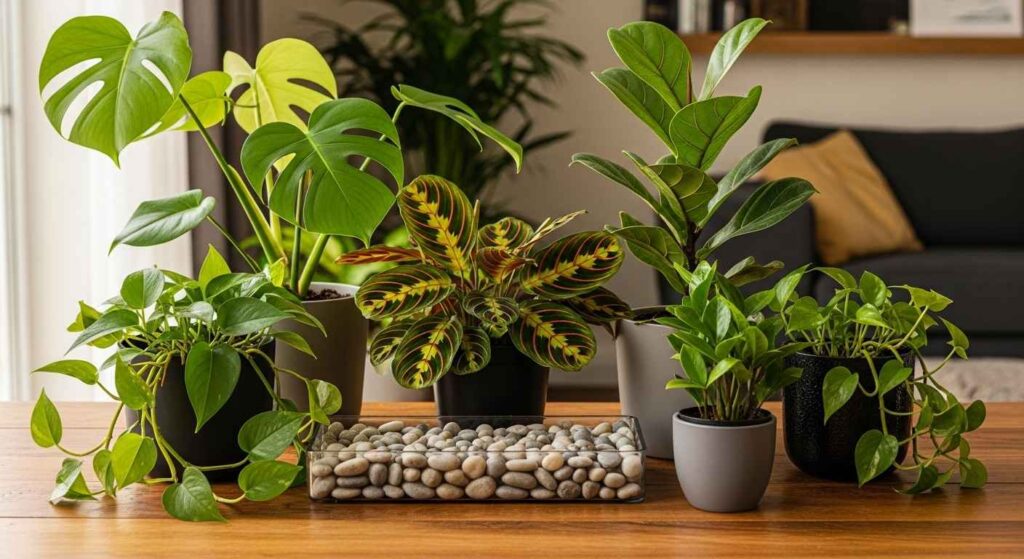
Fertilizer and Growth Expectations
Winter is not the time for heavy feeding. Don’t be tempted to water more or feed them. It will do more harm than good.
Winter Fertilizing Rules
- Stop regular fertilizing: Most plants don’t need fertilizer from November to March
- Exceptions: Flowering plants and citrus trees may need light monthly feeding
- Resume in spring: Begin feeding again when you see new growth
Normal Winter Changes
Don’t panic if your plants show these normal winter behaviors:
- Slower growth or no new growth
- Some leaf dropping (especially older, lower leaves)
- Less vibrant leaf colors
- Slightly droopy appearance
Common Winter Plant Problems and Solutions
Yellow Leaves
Usually caused by overwatering or insufficient light. Reduce watering frequency and move to a brighter location.
Brown Leaf Tips
Indicates low humidity or mineral buildup from tap water. Increase humidity and use filtered water.
Pest Problems
Houseplants are more susceptible to indoor pests during winter. Check regularly for:
- Spider mites: Fine webbing on leaves
- Scale insects: Small brown bumps on stems
- Fungus gnats: Tiny flies around soil
Treat problems immediately with insecticidal soap or neem oil.
Plant-Specific Winter Care Tips
Succulents and Cacti
- Water every 3-4 weeks or when soil is completely dry
- Provide maximum available light
- Keep in cooler rooms (60-65°F) if possible
Tropical Plants (Pothos, Monstera, Philodendron)
- Maintain higher humidity (50%+)
- Keep soil slightly moist but not soggy
- Watch for signs of cold stress near windows
Citrus Trees
Citrus species tend to do better with more consistent moisture than other houseplants in winter.
- Continue light monthly fertilizing
- Maintain consistent watering
- Provide as much light as possible
When NOT to Repot
The best time to repot most plants is from spring to autumn. Worst time to repot? Yep, winter.
Avoid repotting during winter unless absolutely necessary (root rot, broken pot). If you must repot, provide extra warmth and care during recovery.
Preparing for Spring Growth
Start preparing your plants for active growth in late February or early March:
Gradual Changes
- Slowly increase watering frequency
- Begin monthly fertilizing when new growth appears
- Clean leaves to prepare for stronger spring light
- Check for any needed repotting
Spring Transition Tips
- Move plants closer to windows as days get longer
- Watch for new growth as a signal to resume normal care
- Inspect for any pest problems that developed over winter
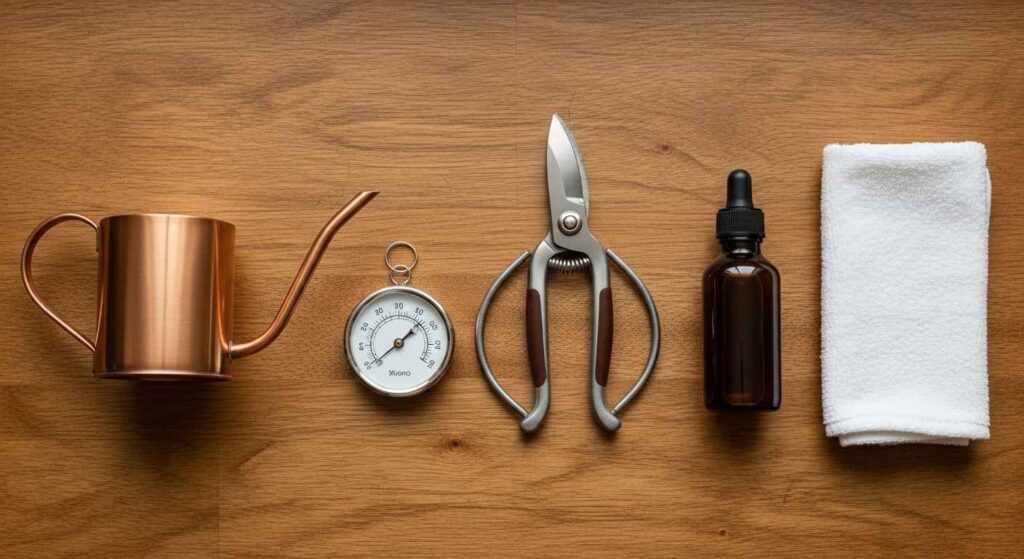
Quick Winter Plant Care Checklist
Print this checklist and keep it handy:
Weekly Tasks:
- Check soil moisture before watering
- Look for pest problems
- Rotate plants for even light exposure
Monthly Tasks:
- Clean plant leaves with damp cloth
- Check humidity levels
- Inspect for signs of stress or disease
- Clean windows for maximum light
Seasonal Tasks:
- Move plants away from cold windows and heating sources
- Reduce watering and stop fertilizing
- Group plants for better humidity
- Plan for spring care changes
Winter plant care doesn’t have to be complicated. The key is understanding that your plants need less of almost everything during these dormant months. Less water, less food, and less fussing will keep them healthy until spring returns.
Remember that some leaf drop and slower growth are completely normal. Your plants are just conserving energy for the growing season ahead. With these tips, your indoor garden will survive winter and be ready to flourish when warmer weather returns.
For more home and garden tips, check out our guides on organizing small spaces and eco-friendly home solutions.
